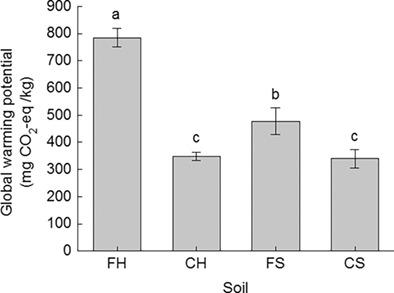当前位置:
X-MOL 学术
›
Ecol. Res.
›
论文详情
Our official English website, www.x-mol.net, welcomes your
feedback! (Note: you will need to create a separate account there.)
Greenhouse gas emissions are affected by land use type in two agroforestry systems: Results from an incubation experiment
Ecological Research ( IF 1.7 ) Pub Date : 2020-08-14 , DOI: 10.1111/1440-1703.12162 Ping Li 1, 2 , Man Lang 1, 2 , Sixi Zhu 2, 3 , Edward W. Bork 4 , Cameron N. Carlyle 4 , Scott X. Chang 2
Ecological Research ( IF 1.7 ) Pub Date : 2020-08-14 , DOI: 10.1111/1440-1703.12162 Ping Li 1, 2 , Man Lang 1, 2 , Sixi Zhu 2, 3 , Edward W. Bork 4 , Cameron N. Carlyle 4 , Scott X. Chang 2
Affiliation

|
In order to better understand factors affecting greenhouse gas (GHG) emissions in Canadian agroforestry systems, we conducted a laboratory incubation study to assess N2O, CO2 and CH4 emissions from soils in response to land use (forestland vs. cropland) and agroforestry system type (hedgerow vs. shelterbelt) in central Alberta, Canada. Emissions of N2O were lower in soils from forestland than cropland, and forest soils acted as a net sink of atmospheric CH4 while cropland soils were weak sources of CH4. However, the forest soil had higher CO2 emission rates than the cropland soil within both agroforestry systems. Soil CH4 oxidation was higher in soil from hedgerow (consisted of natural forest vegetation) than from shelterbelt system (planted forest vegetation), while the former also had lower N2O emissions. Overall, soil CO2 emissions were significantly higher from hedgerow than from shelterbelt systems. Emissions of N2O were positively related with gross nitrification rates and soil pH, and negatively related with gross N immobilization rates. The CO2 emissions were positively related with water‐soluble organic C contents, while CH4 emissions were positively related with clay content, but negatively with gross N immobilization rates and soil organic C content. The global warming potential was higher in forestland soil than in cropland soil within agroforestry systems, and higher in forestland soil of the hedgerow compared to that in shelterbelts. Our results suggest that we need to select land uses or agroforestry systems that have a higher potential of mitigating GHG emissions from soils.
中文翻译:

两种农林业系统中的温室气体排放受土地利用类型的影响:孵化实验的结果
为了更好地了解影响加拿大农林业系统中温室气体(GHG)排放的因素,我们进行了一项实验室孵化研究,以评估土壤对N 2 O,CO 2和CH 4排放的响应,以响应土地利用(林地vs.农田)和加拿大艾伯塔省中部的农林业系统类型(树篱与防护林)。林地土壤中N 2 O的排放量低于农田,森林土壤是大气中CH 4的净汇,而农田土壤是CH 4的弱源。然而,在两种农林业系统中,森林土壤的CO 2排放率均高于农田土壤。土壤CH 4篱笆(由天然森林植被组成)土壤中的氧化程度高于防护林系统(种植的森林植被)中土壤的氧化程度,而前者的N 2 O排放量也较低。总体而言,树篱的土壤CO 2排放量明显高于防护林系统。N 2 O的排放与总硝化率和土壤pH值呈正相关,与总固氮率呈负相关。CO 2排放与水溶性有机碳含量呈正相关,而CH 4排放与粘土含量成正相关,但与固定氮总量和土壤有机碳含量成负相关。与防护林地带相比,农林系统中林地土壤的全球变暖潜力要高于农田林地,而树篱的林地土壤的增温潜力更高。我们的结果表明,我们需要选择具有更大潜力来缓解土壤温室气体排放的土地利用或农林业系统。
更新日期:2020-08-14
中文翻译:

两种农林业系统中的温室气体排放受土地利用类型的影响:孵化实验的结果
为了更好地了解影响加拿大农林业系统中温室气体(GHG)排放的因素,我们进行了一项实验室孵化研究,以评估土壤对N 2 O,CO 2和CH 4排放的响应,以响应土地利用(林地vs.农田)和加拿大艾伯塔省中部的农林业系统类型(树篱与防护林)。林地土壤中N 2 O的排放量低于农田,森林土壤是大气中CH 4的净汇,而农田土壤是CH 4的弱源。然而,在两种农林业系统中,森林土壤的CO 2排放率均高于农田土壤。土壤CH 4篱笆(由天然森林植被组成)土壤中的氧化程度高于防护林系统(种植的森林植被)中土壤的氧化程度,而前者的N 2 O排放量也较低。总体而言,树篱的土壤CO 2排放量明显高于防护林系统。N 2 O的排放与总硝化率和土壤pH值呈正相关,与总固氮率呈负相关。CO 2排放与水溶性有机碳含量呈正相关,而CH 4排放与粘土含量成正相关,但与固定氮总量和土壤有机碳含量成负相关。与防护林地带相比,农林系统中林地土壤的全球变暖潜力要高于农田林地,而树篱的林地土壤的增温潜力更高。我们的结果表明,我们需要选择具有更大潜力来缓解土壤温室气体排放的土地利用或农林业系统。











































 京公网安备 11010802027423号
京公网安备 11010802027423号